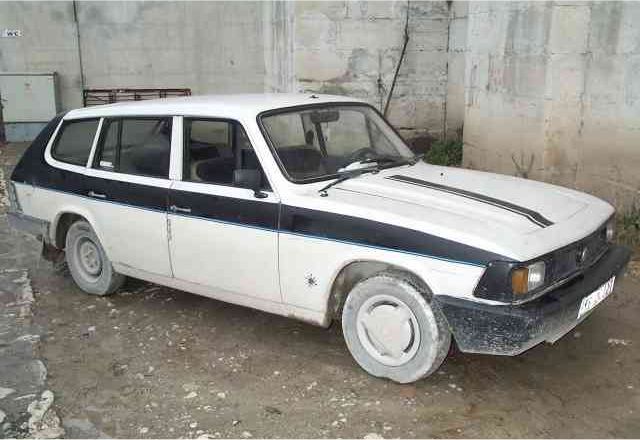Stepping into a vintage car showroom in Ankara, you might spot an unusual sight — a sleek, two-tone station wagon with distinctive lines and a compelling presence. This isn’t just any classic car; it’s the Anadol SV 1600, a testament to Turkish engineering ambition and innovation of the late 1970s.
In an era when automotive giants dominated global markets, Turkey boldly ventured into car manufacturing with the Anadol brand. The SV 1600 emerged as their crowning achievement, combining British design expertise, Ford engineering, and Turkish innovation in a unique package that would shape the nation’s automotive industry.
The Birth of Turkish Automotive Innovation
Turkey’s journey into automobile manufacturing began with a vision to establish domestic production capabilities. The Anadol SV 1600 represented the culmination of this ambition, developed through a strategic partnership with British Reliant and powered by Ford technology.
The decision to use fiberglass for body construction proved revolutionary for the time. This choice wasn’t merely about weight reduction — it represented a bold step toward modern manufacturing techniques in a market dominated by traditional steel bodies.
«The Anadol SV 1600 wasn’t just another car — it was a statement of Turkish industrial capability,» notes Ibrahim Yilmaz, a prominent classic car collector in Istanbul. «Its fiberglass construction and Ford powerplant created a unique combination that still fascinates enthusiasts today.»
The production run from 1973 to 1981 saw approximately 6,000 units manufactured, each one contributing to Turkey’s automotive heritage. This relatively limited production volume has contributed to the model’s current collector status.
Fact!
The Anadol SV 1600's fiberglass body made it one of the few mass-produced cars in Europe using this material, predating similar applications by major manufacturers.
Engineering Marvel: Under the Hood
At the heart of the Anadol SV 1600 beats a Ford Kent Crossflow engine, a 1.6-liter powerplant delivering 65 horsepower. While these numbers might seem modest by today’s standards, they provided adequate performance for a family vehicle in the late 1970s.
The engineering team focused on creating a robust platform suitable for Turkish roads and climate conditions. The H-shaped chassis provided exceptional structural rigidity, while the fiberglass body offered natural resistance to corrosion — a significant advantage over contemporary steel-bodied competitors.
Key engineering features that set the SV 1600 apart include:
- lightweight construction techniques pioneering for their time;
- corrosion-resistant fiberglass body panels requiring minimal maintenance;
- adaptable suspension system designed for varied road conditions;
- serviceable Ford engine with widely available parts;
- practical station wagon design maximizing interior space.
These engineering choices reflected a pragmatic approach to automotive design, prioritizing durability and serviceability.
Design Evolution and Market Impact
The 1978 model year brought significant aesthetic updates, most notably the introduction of a distinctive two-tone paint scheme that became the car’s signature look. This design element helped distinguish the Anadol in an increasingly competitive market.
«What made the SV 1600 special was its unique blend of European design sensibilities with distinctly Turkish character,» explains Dr. Mehmet Kaplan, automotive historian at Istanbul Technical University. «The two-tone paint scheme of the 1978 model particularly exemplified this fusion of styles.»
Historical Reference!
The Anadol SV 1600's design was partially influenced by the Reliant FW11, but Turkish engineers modified it significantly to suit local market preferences and production capabilities.
Market positioning targeted the growing Turkish middle class, offering a practical family vehicle with modern features and distinctive styling. The model’s success paved the way for future developments in Turkey’s automotive sector.
Legacy and Modern Appeal
Today, the Anadol SV 1600 enjoys a special status among classic car enthusiasts. Well-maintained examples command increasing attention at vintage car shows, with prices reflecting growing collector interest.
Current market values show steady appreciation, with restored examples fetching significant premiums. A 1978 model recently listed in Ankara for 110,000 Turkish lira demonstrates the model’s enduring value proposition.
Important!
Original spare parts, while increasingly rare, can still be sourced through specialized networks of enthusiasts and restoration specialists across Turkey.
The car’s practical attributes — including the corrosion-resistant body and straightforward mechanical layout — make it an attractive proposition for collectors seeking a usable classic car.
Bridging Past and Future
The Anadol SV 1600 represents more than just Turkey’s first mass-produced passenger car — it embodies the nation’s industrial awakening. Its innovative use of materials and pragmatic engineering solutions continue to impress automotive enthusiasts worldwide.
As classic car values rise globally, the Anadol SV 1600 stands poised for recognition beyond Turkish borders. Its unique combination of Ford reliability, innovative construction, and historical significance makes it an increasingly attractive prospect for international collectors.
Pros and Cons
| Advantages | Disadvantages |
|---|---|
| Historically significant as Turkey’s pioneering automobile | Limited production numbers make finding parts challenging |
| Corrosion-resistant fiberglass body construction | Performance modest by modern standards |
| Reliable Ford engine with good parts availability | Restoration expertise increasingly hard to find |
| Unique styling with distinctive two-tone paint scheme | Limited international recognition affects collector value |
| Growing collector interest driving value appreciation | Interior materials show age more readily than contemporaries |
| Practical station wagon design with ample cargo space | Specialized knowledge required for fiberglass body repairs |
| Strong enthusiast community in Turkey | Original documentation often missing |
The Anadol SV 1600 stands as a compelling testament to Turkey’s automotive ambitions. While it presents certain challenges for modern collectors, its historical significance, innovative construction, and growing appreciation among enthusiasts make it an increasingly attractive classic car proposition. The model’s unique position in automotive history, combined with its practical attributes, suggests continued value appreciation for well-preserved examples.

